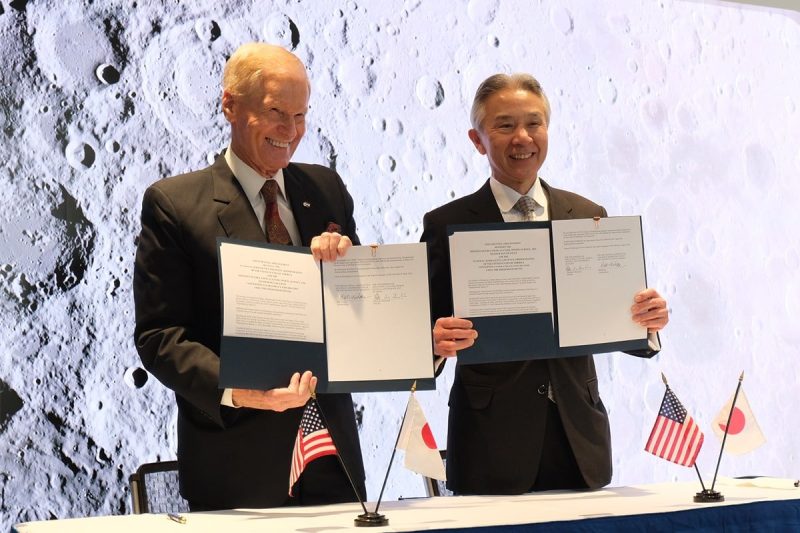NASA and Japan Sign Agreement for Lunar Rover and Advance Space Cooperation

To promote sustainable human exploration of the Moon, NASA Administrator Bill Nelson and Japan’s Minister of Education, Culture, Sports, Science and Technology (MEXT), Masahito Moriyama, have inked a deal.
Japan is going to design, develop, and run a pressurized rover for both crewed and uncrewed lunar exploration. NASA will handle the rover’s launch and delivery to the Moon in addition to giving Japanese astronauts two chances to visit the lunar surface.
“A shared goal for a Japanese national to be the first non-American astronaut to land on the Moon on a future Artemis mission, assuming important benchmarks are achieved” was also stated today by President Biden and Prime Minister Kishida.
It is the goal of the pressurized lunar rover to allow astronauts to work longer and go farther on the lunar surface. The signing ceremony was held at NASA Headquarters in Washington on April 9. President of JAXA (Japan Aerospace Exploration Agency) Hiroshi Yamakawa signed with Nelson and Moriyama.
“The quest for the stars is led by nations that explore the cosmos openly, in peace, and together. This is true for the United States and Japan under the leadership of President Biden and Prime Minister Kishida,” said Nelson. “America no longer will walk on the Moon alone. With this new rover, we will uncover groundbreaking discoveries on the lunar surface that will benefit humanity and inspire the Artemis Generation.”
An enclosed, pressurized rover will act as a mobile house and laboratory for the astronauts to live and work for extended periods of time, allowing them to travel farther and perform study in geographically diverse places. It will be able to carry two astronauts who will travel across the region close to the lunar South Pole for a maximum of thirty days. With a roughly ten-year lifespan, NASA now intends to employ the pressurized rover on Artemis VII and future missions.
“It was an honor to sign the historic implementing arrangement that will be long remembered as the symbol of the new era of Japan-U.S. partnership for the lunar exploration,” said Moriyama. “Under the partnership stronger than ever, we will drive the initiative together with JAXA, including the development of the pressurized rover that vastly extends the exploration capability on the lunar surface, to realize the shared goal for Japanese and American astronauts to, together, explore the moon.”
Recognizing the countries’ shared interest in peaceful exploration, the agreement is based on the “Framework Agreement Between the Government of Japan and the Government of the United States of America for Cooperation in Space Exploration and Use of Outer Space, Including the Moon and Other Celestial Bodies, For Peaceful Purposes,” which was signed in January 2023.
Many cooperative efforts between the nations are made possible by the framework agreement, such as space science, Earth science, space operations and exploration, aerospace science and technology, space technology, space transportation, safety, and mission assurance, among many other areas. The partners will expand on the framework agreement by signing future agreements for Japan’s involvement in NASA’s Dragonfly mission and the Nancy Grace Roman Space Telescope, in addition to the agreement for lunar surface exploration. Additionally, the United States and Japan plan to work together on JAXA’s Next-generation Solar-observing Satellite, or SOLAR-C, which will observe the Sun’s ultraviolet radiation in order to shed light on the mysteries of solar atmospheres.
“The pressurized rover will be a powerful contribution to the overall Artemis architecture as Japan and the U.S. go hand in hand with international and industry partners to the lunar surface and beyond,” said Yamakawa. “JAXA is ready to assist MEXT and push this forward with our science and technological expertise to establish sustainable human presence on the Moon.”
As per the 2022 Gateway Implementing Arrangement, Japan will supply Gateway’s environmental control, life support systems, and cargo transportation, while NASA will offer a chance for a Japanese astronaut to be a member of the Gateway crew on a future Artemis mission.
For the benefit of everybody, NASA will use Artemis to land the first woman, the first person of color, and its first astronaut with an international partner on the moon, as well as to make new scientific discoveries and explore a larger area of the moon than has ever been done before.